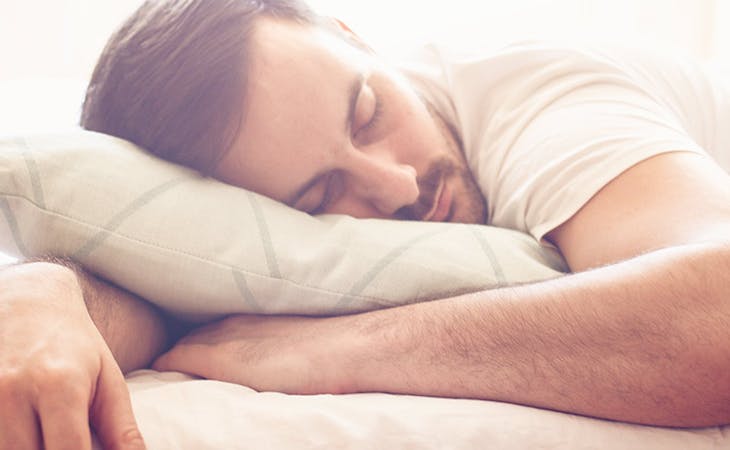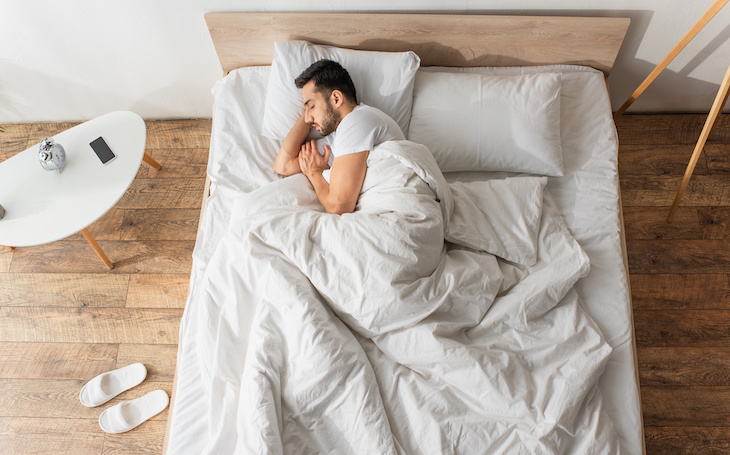If you have back pain, getting a good night’s sleep can be a challenge. All that tossing and turning isn’t just rough on your spine—it can leave you feeling groggy and unfocused the following day.
“Sleep is essential to pain management,” says Terry Cralle, RN, clinical sleep educator and author of Sleeping Your Way to the Top: How to Get the Sleep You Need. “It’s necessary for joint repair and cellular repair during the night.”
We’ve discussed previously how to determine if your mattress is playing a role in your back pain and what to consider when you’re shopping for a new one. If you don’t know how to sleep with back pain, it can make getting a good night’s sleep pretty difficult. Experts say even if you have the best mattress for back pain, there are other tips and tricks that can make for a more restful slumber.
Here’s how to sleep with back pain.
Pay attention to sleep position
While you might remember being told as a kid to stand up straighter, spine experts say good posture is just as important when you’re lying down. “It will help prevent stress points that may aggravate joints and the connective tissue that holds you together,” says Robert Hayden, a chiropractor in greater Atlanta and spokesman for the American Chiropractic Association.
Ideally, says Hayden, you should sleep on your side, holding a body pillow. By using the pillow to support your upper arm and upper knee, you’ll keep your spine straight while you sleep and help reduce back pain.
If you’re a stomach sleeper, you might want to see if you can train yourself to fall asleep in another position. “Typically, sleeping on your stomach can flatten the natural curve of your spine, putting some additional strain on your back muscles,” Santhosh Thomas, medical director of the Center for Spine Health at the Cleveland Clinic, tells EverydayHealth.com.
Regardless, pillows can help reduce back pain while sleeping and make up for spinal issues caused by your natural sleep posture. If you sleep on your stomach, you might benefit by placing a relatively flat pillow under your belly and hip area to elevate your pelvis slightly. Back sleepers might be more comfortable with a small pillow underneath the knees, which will help support the lower back and minimize lower back pain while sleeping.
Finally, the pillow under your head also plays a key role in supporting your cervical spine, says David Coppola, a chiropractor and holistic doctor in Key Largo, Fla. “A pillow should be manually malleable to support the curvature of your neck,” he says. “It should be folded in half or scrunched when sleeping on your side to account for the distance between your shoulder and spine, thereby maintaining straight spinal integrity.”
Take steps to let go of tension
Unfortunately, the stresses of your day don’t always melt away when you shut your eyes. So take some steps before bed to help you unwind the tension that can contribute to a sore back and shoulders.
“A good night’s sleep involves preparation,” says Coppola. “Have a routine to send messages to your brain and body that it’s time for bed.”
First, shut off the TV—or banish it from the bedroom entirely. Block unwanted sounds with a white noise machine or soft ambient music, and use blackout drapes or a sleep mask if you have a streetlight out the window (or a partner who likes to wind down by reading in bed).
Next, put away your cell phone. Not only does this avoid the blue light that can disrupt your natural circadian rhythm, but it will get your mind off work, the news, and other stressors that can keep you from sleep.
Finally, quiet your mind. “Meditation, breathing exercises, and visual imagery can help you let go of daily rigors,” says Coppola. Once you create a good bedtime routine, you’ll know how to send your body the signal that it’s time to hit the hay. If you need some suggestions, check out these 10 nighttime activities to help you relax.











